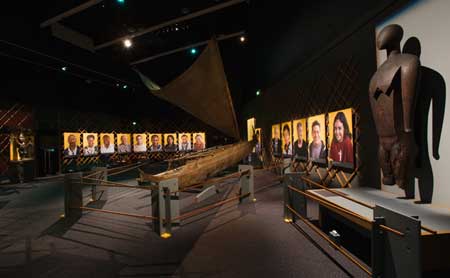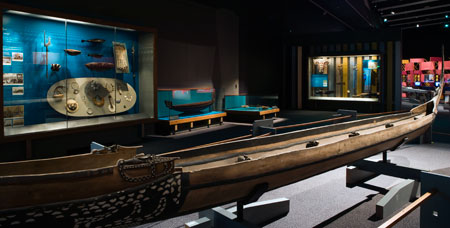review by Chris Ballard
The first image that greets you on entering Voyages of the Pacific Ancestors: Vaka Moana at the National Museum of Australia is a giant canvas, of sail-like proportions, onto which is projected footage of a dark, roiling ocean, shot from just above water level — from the perspective of a lifejacket, perhaps. This, as the Tongan scholar Epeli Hau'ofa described it, is the optic of the 'continental men' or Europeans for whom the islands of the Pacific appeared as tiny specks in the immensity of the ocean. No less astounding for early European voyagers than the sheer size of the Pacific was the fact that most of the habitable islands were already occupied, and by communities of an almost dazzling variety.
Two semi-circles of images address each other in the first exhibition space: portrait photographs of living Oceanians, from Papua New Guinea in the west to Easter Island in the east, and from Hawai'i and Micronesia in the north to New Zealand in the south; facing them is a pantheon of their ancestors, spirits and gods in carved form. The question first posed by Captain Cook at Hawai'i in 1778 still resonates: 'How shall we account for this Nation spreading itself so far over the Vast ocean?'
Opinions have ranged widely since, from Cook's appreciation of the seafaring and navigational skills of his Oceanic contemporaries, to the rather dismissive conclusion of historian Andrew Sharp, advanced as recently as 1956, that the Pacific had been settled through a long history of one-way accidental or drift voyages. Drawing to considerable effect on the latest scholarship, and through an intelligent blend of different media and materials, this exhibition fairly decisively lays Sharp's views to rest.

photograph by Lannon Harley
National Museum of Australia
Canoes are undoubtedly a central motif, and they provide a handy metaphor for the more general themes running through the exhibition of variation and connection. Austronesian terms for canoes — such as wanga, waka, va'a — are obvious variants on a common root, and the astonishing range of canoe prows or the forms for canoes and rigs, illustrated on a huge map, suggests the ebb and flow of innovation, diffusion and recomposition in seafaring culture and technology across the region. Canoes featured range from the reconstructed cross-section of the giant Brittane double-hulled canoe, to the small models produced across the Pacific — not just for tourists but also for competitive races, and important in their own right as sources of knowledge about obsolete canoe forms and techniques.
However, as suggested by Penny Morrison of the Auckland Museum, the real hero is the story, for which the canoes serve as vehicles. By carefully assembling a range of different lines of evidence — from archaeology, linguistics and genetics, as well as oral tradition and 'experimental' voyaging — the exhibition offers a compelling account of the history of human settlement and connection across the Pacific.
We now know, for example, that the first burst of colonisation into 'Remote Oceania', beyond the south-east Solomon Islands, was remarkably fast. Early Lapita sites indicate that just four or five generations separated the original pioneers who left the Bismarck Archipelago from their descendants arriving in Tonga; did anyone of this period die on the same island on which they were born?

photograph by Lannon Harley
National Museum of Australia
Archaeology supplies not just the chronology of settlement — and it does so with increasing precision — but also the proxy evidence for subsequent movement and exchange between island groups. This evidence includes such materials as Hawaiian adze blades unearthed in the Tuamotu Islands of Central Polynesia, or fragments of the glass-like obsidian transported from the Bismarck Archipelago sources, which is found, like a social tracer dye, in sites ranging from the Philippines and Borneo in the west to Fiji and Tonga in the east.
The genetic records for people, as well as for the plants (taro, breadfruit and coconut among them) and animals (rats, chickens and dogs) that travelled with them, are generating a much richer sense of the pace, complexity and repetition of movements both during and after colonisation. Among the more exciting — and controversial — recent finds are the presence of South American sweet potato in the central Polynesian Cook Islands by about 1000 AD, and the appearance of Polynesian chicken in pre-Colombian South American sites. All the evidence of this exhibition suggests that Polynesian voyagers not only reached South America and returned, but also that they may have done so on more than one occasion.
Enough has been established about the environmental conditions (wind patterns, ocean currents and seasonal variation), Indigenous seafaring knowledge, and the technological capacity of historic Oceanic vessels (though accurate modelling or reconstruction of ancient canoes remains problematic) for scholars such as Geoff Irwin to set out some of the likely methods employed in the settlement of the Pacific. Rather than launching out boldly in colonising fleets, Pacific voyagers almost certainly explored the unknown horizon with caution and due respect for the ocean, venturing against the wind in expanding loops, always confident that they could reach their point of departure. Once the presence of new land was established, these scouts returned immediately to plan for actual colonisation. Elaborate traditions of navigation, communicated on land with the aid of stick charts and star compasses, and then practised and implemented at sea, further reduced the risks.
The documentation and maintenance of those traditions — of navigation, of canoe construction and of the stories of specific canoes and voyagers — feature prominently in the exhibition. Video clips of mothers, elders and others recount key narratives, such as the story of the vast Uvean twin-hulled vessel, the Lomipeau, which was used to transport the giant slabs of stone employed in the construction of Tongan chiefly burial mounds.
Since the 1970s, an extraordinary renaissance in traditional Oceanic seafaring or 'wayfinding' has powerfully reasserted the capacity of Pacific Islanders to maintain long-distance links. Reconstructed twin-hulled canoes such as Hôkûle'a, Hawaikinui and Te Aurere have settled many lingering questions about ancient voyaging, while raising further challenges for their crews and for scholars alike. More than just an exercise in experimental voyaging, these have been projects of reconception, restoring a sense of the ocean as linking rather than separating, and allowing for the possibility of a material and social Oceanic universe that is potentially unbounded.
The boundaries established by European voyagers, metropolitan scholars and colonial states — such as those insidious distinctions between Polynesia, Micronesia and Melanesia — have constrained rather than enhanced explanation and understanding of the past and present in Oceania, atomising former networks through which ideas, material and people were exchanged. Nothing makes this point more clearly than the composition of the double-hulled 'Fijian' ndrua canoe, which combined Fijian timber, Tongan and Uvean design and handling skills, and a Micronesian-inspired rig, constructed by Samoans brought to Fiji by Tongans.
The present exhibition is a voyaging vessel on the scale of the Lomipeau canoe. Created at the Auckland Museum, it has travelled to Japan and Taiwan (closing the almost 4000-year-old loop on this Austronesian homeland) and then to Korea before coming to Australia. From Canberra, it leaves for Amsterdam, France and then Canada and the United States before returning to New Zealand in 2011.
There's a particularly efficient and clever use of different media at work in this exhibition. A deliberate sparseness of material on display, with attention centred on just a handful of full-scale canoes, invokes a sense of Oceanic space, while islands of cases containing smaller objects and clouds of text and video combine to excellent effect. The 360-page catalogue, edited by historian Kerry Howe, is a tour de force in itself, with essays by Ben Finney, Geoff Irwin and Anne Salmond among others, and a wealth of illustration, including reproductions of early European engravings and Herb Kane's imaginative reconstructions in oil of ancient voyaging canoes under full sail.
Turn, as you exit the exhibition, to glance again at the ocean footage — for this landlubber, at least, some of the menace has been drained from the image, replaced by awe at the capacity of Oceanians, past and present, to embrace and find their way through an ocean world.
Chris Ballard is a fellow in the Division of Pacific and Asian History in the College of Asia and the Pacific, at The Australian National University.
| Exhibition: | Voyages of the Pacific Ancestors: Vaka Moana |
| Institution: | Auckland War Memorial Museum Tamaki Paenga Hira |
| Development team: | Rodney Wilson (concept leader), Graham Soughtton (project manager), Roger Neich and Fuli Pereira (inhouse curators) |
| Exhibition space: | 840 square metres |
|
Venue/dates: | National Museum of Australia, Canberra, 5 June 2009 – 18 October 2009 |
| Catalogue: | Kerry Howe (ed.), Vaka Moana: Voyages of the Ancestors, RRP A$90 |
